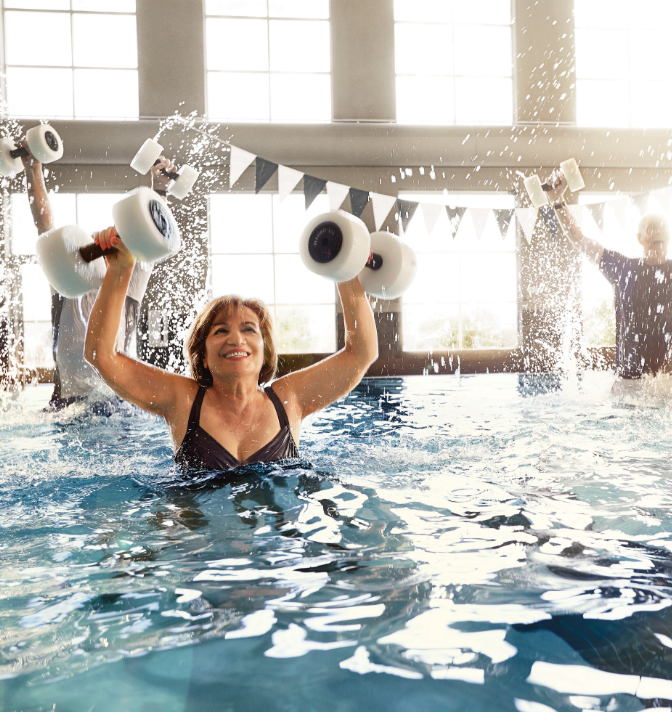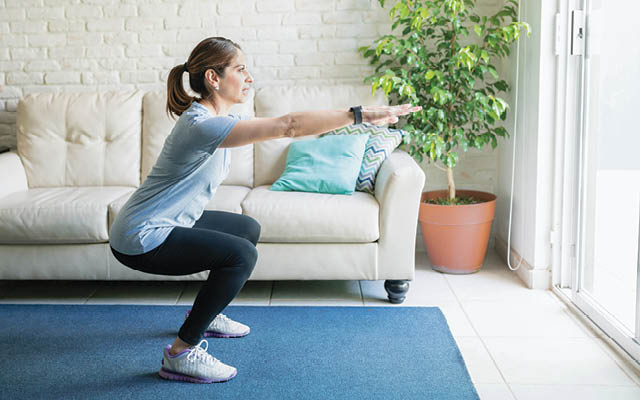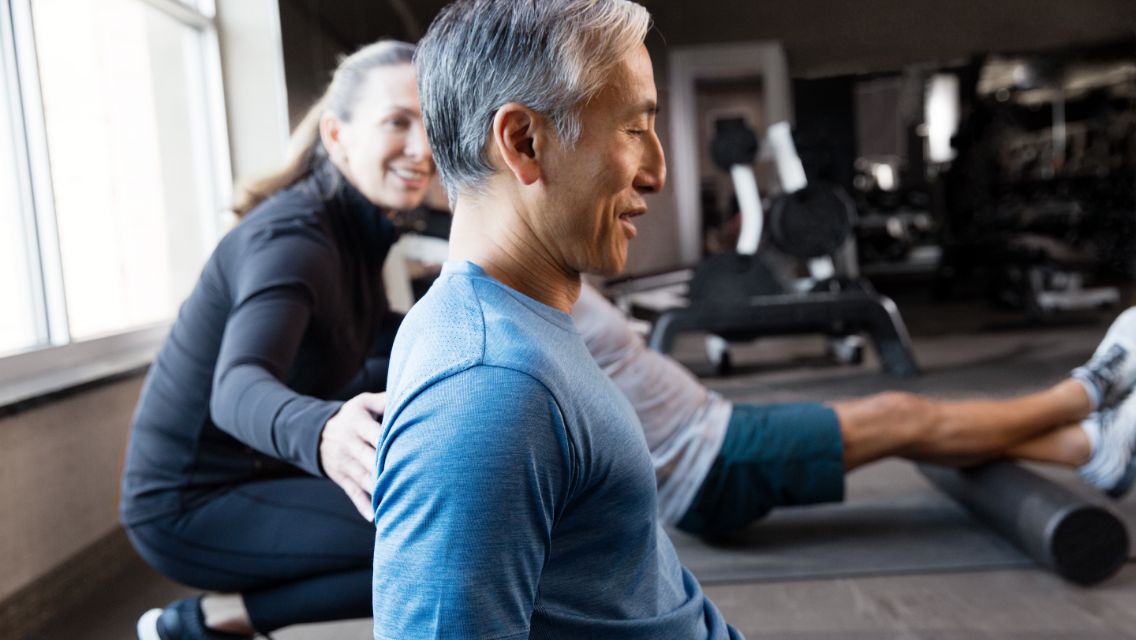For those living with arthritis and the corresponding joint pain, stiffness, and fatigue, traditional workouts can be challenging. Yet moving your body is one of the most effective strategies for managing arthritis symptoms. The key is not to be fearful or avoidant of exercise — but rather to listen to your body and know how to move in ways that support your joints instead of straining them.
Over my 25 years as a fitness professional, I have worked with many clients dealing with arthritis. Pain and discomfort can be an obstacle, but proactive care and healthy habits can help reduce inflammation and improve your condition.
A Look at Two Types of Arthritis
There are more than 100 types of arthritis, yet the most common form is osteoarthritis, with rheumatoid arthritis being another prevalent type.
Osteoarthritis refers to arthritis that develops from wear and tear, whether from a breakdown in cartilage, injuries, or overuse. Rheumatoid arthritis is an autoimmune disease in which inflammation occurs from the body attacking the lining of the joints.
Both conditions can be improved from incorporating exercise and other healthy lifestyle choices, though rheumatoid arthritis may need more attention and assistance from medical professionals to help reduce inflammation.
With either type, it’s best to take advantage of the days when you feel your best by being active — and also to give yourself permission to recover when need to. Those with arthritis may benefit from engaging in movement even when they are a little uncomfortable, but it is still important to balance out workouts with proper rest and recovery. Always seek advice and direction from qualified professionals.
The Importance of Maintaining Muscle and Movement
As we age, it’s common to lose muscle mass and strength, and it takes effort to maintain it. Preserving muscle mass is especially important for those dealing with arthritis. If not addressed and prioritized, arthritis has the potential to be devastating to everyday function and quality of life by adding pain and stiffness to that loss of muscle and strength.
If arthritis is already present, the best plan of action for increasing strength is to gradually increase your exercise frequency and intensity, as well as the duration of your workouts, while also ensuring adequate time for recovery between workouts. For efficiency and to help improve overall functional strength, it’s important to prioritize larger muscle groups and multi-joint compound movements.
Creating a routine you can stick to is crucial. You may very well start off with two or three days a week of exercise that expands to three to five days over time. When exercise is a regular part of life, arthritis can be easier to deal with. It’s not the only solution, but it is an important piece of the puzzle.
5 Recommended Exercise Modalities for Dealing With Arthritis
1. Functional Strength Training
When I work with clients with arthritis, I often emphasize the importance of functional training. The best exercises are ones that help you move better during your daily life and regular activities. These include even the basic movements of sitting down or standing up, getting dressed, putting dishes away, carrying groceries, going up stairs, and more.
While some might take these abilities for granted, they all require a level of strength and joint mobility, which is important to keep working on — especially for those with arthritis. Exercises that require pressing and pulling both horizontally and vertically, squatting (sitting to standing), hinging at the hips, stepping up or down, and rotating motions are beneficial as they all require using more than one joint at a time while incorporating multiple planes of motion. They mimic our everyday functions.
As for equipment, resistance bands and cable machines are a good place to start if you’re a beginner. I recommend waiting to use free weights like dumbbells or kettlebells until you’ve developed more control of your movements, which can take a few weeks or months.
2. Core Strengthening Moves
When managing arthritis, it’s crucial to focus on exercises related to core strength and balance. These moves help stabilize the body and support the joints, helping to reduce pain and improve overall function.
By challenging your core in your workouts, you’re preparing your body to better handle forces and movements encountered in daily life without putting extra strain on your spine or arthritic joints. Examples of these types of exercises include arm or leg lifts in a quadruped position, floor bridges, planks, and Pallof presses. Incorporating these into your regimen can improve your balance, enhance joint support, and contribute to more comfortable, confident movement.
3. Flexibility and Mobility Work
Flexibility and mobility exercises are essential to help you move and feel better overall. They focus on increasing your joints’ range of motion, easing stiffness, and improving posture and alignment.
A smart first step is working with a fitness professional who specializes in corrective exercise. Through a movement assessment, they can identify muscular imbalances and restricted areas that may be contributing to joint discomfort. These insights can help them tailor a program for you that targets your specific limitations and builds a more balanced, functional body.
4. Low-Impact Cardio
Our heart and lungs contribute to many other systems of the body, so it’s important to strengthen them by incorporating cardio sessions into your routine, ideally two to three times per week. Opting for low-impact cardiovascular exercises like walking, swimming, or biking can help reduce any strain on your joints. As with strength training, you can start off slow (as little as 10-minute sessions) and gradually increase duration and intensity as your body allows.
5. Activities That Bring You Joy
When you find pleasure in being active, it’s much easier to stay consistent. Maybe you love scenic hikes, spending time on the golf course, or playing pickleball — whatever gets you moving while you are also enjoying the experience. As you continue to work on your strength and mobility, your body will be better able to perform the activities you love.
A Few Tips Before You Start
Consult the experts and find support in your network.
Be sure to check with your healthcare provider before starting any kind of exercise program — and consider working with a personal trainer or other fitness professional. For best overall results, having qualified people to assist and support you can help with staying motivated and accountable while also gaining a better understanding of your condition. You might also want to lean on a close friend or family member as having people in your corner can improve your overall experience and help you feel more supported.
Listen to your body and manage pain wisely.
When exercising with arthritis, it’s essential to stay in tune with your body and your pain levels. Joint discomfort is a common part of arthritis, but it’s important to distinguish between general stiffness and sharp or worsening pain. Pushing through the wrong kind of pain can lead to setbacks rather than progress.
If an exercise causes pain, it’s a sign that the movement needs to be modified. Always be prepared to regress the movement (reducing the range of motion, decreasing the weight, or choosing a lower-impact alternative). Early on, especially in the first four to six weeks of a new routine, it’s best to keep workouts within a moderate intensity range that allows you to complete 12 to 20 repetitions per set. The key is to challenge the body without overloading it.
Prioritize recovery.
While staying active is crucial for managing arthritis, recovery is just as important. Without proper rest, your body doesn’t have the chance to repair and adapt, and that can limit the benefits of your exercise routine.
Sleep plays a key role in the recovery process. Aim for at least eight hours of quality sleep per night to support joint health, help reduce inflammation, and improve energy levels.
You also want to allow for adequate recovery between workouts that target the same major muscle groups. If a particular area is sore or fatigued, give it time to recover before working it again.
It’s also wise to build rest into your workout structure. Between sets, give yourself enough time to pause — especially when performing exercises that involve the same joints or muscle groups affected by arthritis.
Prioritizing recovery helps prevent overuse, supports consistent progress, and makes it easier to stay active without aggravating symptoms.





